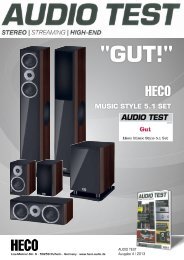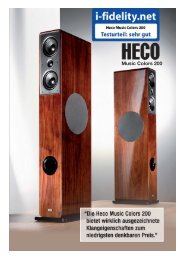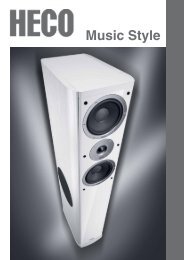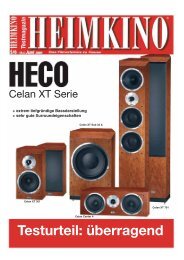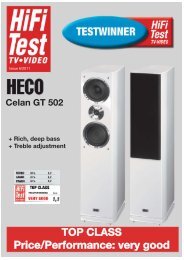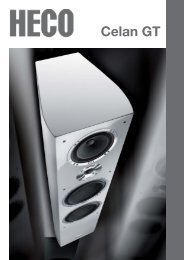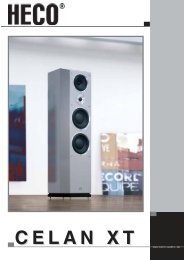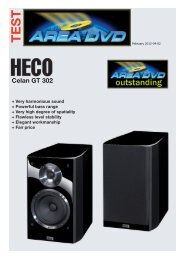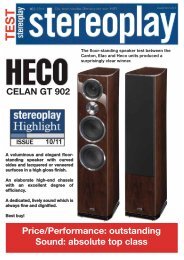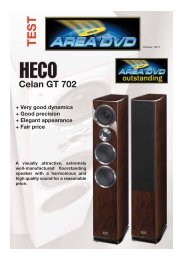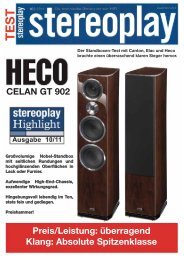Create successful ePaper yourself
Turn your PDF publications into a flip-book with our unique Google optimized e-Paper software.
Celan 500<br />
„Very well-balanced<br />
speaker with low<br />
range levels and extremely<br />
fi ne resolution..“<br />
<strong>TEST</strong> <strong>WINNER</strong><br />
Price/performance „excellent“
Celan 500<br />
<strong>Heco</strong>’s developers appear to have chosen different priorities<br />
when selecting their materials:<br />
The cones are made of a high-density paper mixture,<br />
while the enclosure is impressive with a genuine wood<br />
veneer. However, this certainly doesn’t have to be a disadvantage,<br />
as already shown by the top test results for the<br />
Metas 500 in Audio 4/07. From a distance, only a trained<br />
<strong>Heco</strong> enthusiast would recognise the difference between<br />
the two ranges: While the Metas 500 for € 760 only has a<br />
foil covering, the Celan is also equipped with a subwoofer<br />
reinforced with woven Kevlar. Despite the completely<br />
different shape of the cone, it works with the woofer to<br />
achieve a common volume and looks after the bass range<br />
in the team. It is only above 400 hertz that the crossover<br />
gently fades out the more powerful lower woofer, i.e.<br />
a classic 2.5 way concept.<br />
The treble range was one of the particular strengths of<br />
the Metas. A similarly designed tweeter, though more<br />
refined and with a larger wave guide, now helps Celan<br />
to achieve an even more natural sound. The cone has<br />
been strengthened through the application of additional<br />
nano-particles so as to reduce partial vibrations, which<br />
is designed to place the tweeter in a special position between<br />
hard metal calottes and fabric calottes with a softer<br />
tendency. A metal bridge enables the level to be raised<br />
by two decibels when an excessively dampened room<br />
threatens to absorb the trebles. And there has been no<br />
economizing on the housing: the basic hexagonal form<br />
for avoiding standing waves is more complex and expensive<br />
to construct than a simple box and the veneer has<br />
a very high-quality effect thanks to the good choice of<br />
lacquer used.<br />
The two bass reflex tubes at the rear bring a touch of<br />
heavy industry to the product: made of solid cast, they<br />
are particularly impressive technically through their very<br />
pronounced rounding with a large diameter, leaving<br />
absolutely no possibility for blur or compression. <strong>Heco</strong><br />
performed the first round with “linear” level-adjusted jumpers,<br />
setting itself apart from the more effect-accentuated<br />
Focal with pleasant, finer sounding strings. However, the<br />
deeper tones of Dvorak‘s 9th symphony (Järvi, Telarc)<br />
sounded somewhat too good-natured over the <strong>Heco</strong>,<br />
while the brass section blew distinctly more aggressively<br />
in the final movement with the jumper on “+2b”, without<br />
the never irritating string tones - now even richer in detail<br />
- losing any of their fine beauty. Compared with the Focal,<br />
space projection came across as much more plausible.<br />
Whereas the musicians all seem to be jostling together at<br />
the edge of the stage like would-be soloists in the French<br />
product, the <strong>Heco</strong> drew a wide arc in which the entire<br />
happening takes place with a more coherent and harmonious<br />
effect. The <strong>Heco</strong> showed that it is certainly not soft<br />
with its precise rendition of Sting’s “All This Time” (The<br />
Soul Cages, A&M). Although the <strong>Heco</strong> will often lose in<br />
a quick comparison at the store with its neutral design<br />
matching, those who buy this speaker will be rewarded<br />
with long-lasting audiophile qualities.<br />
What goes together?<br />
…The <strong>Heco</strong> is entirely uncritical, suited to more stable<br />
tube amplifiers with a good efficiency level (86 dB) and<br />
impedance minimum of 4.6 ohms, while remaining tame<br />
in sound and dynamic in the bass ranges…<br />
Partner question<br />
Final round: combining with different amplifiers. The <strong>Heco</strong><br />
really distinguished itself in this regard, eliciting astonishing<br />
dynamics from the not particularly powerful Opera<br />
Audio Consonance M100 Plus tube amp, with even a brief<br />
“overriding” of the amplifier hardly affecting the sound …<br />
Conclusion:<br />
HiFi means “high fidelity” – can there be a matching<br />
or balancing of tastes in this respect? If your answer<br />
to this question is “no”, I would then really recommend<br />
the natural sound of the <strong>Heco</strong>…<br />
Readers’ comments<br />
Rüdiger Fröhlich<br />
„The Celan 500 sounds the most natural – it makes the<br />
cymbals ring out and gets the basses grooving“.<br />
Jürgen Kaufmann<br />
„My favourite is the <strong>Heco</strong> – it’s clearer than the KEF and<br />
also harmonises well with the tube amp.“<br />
Ulf Kuhlmann<br />
„The clear winner for me is the Celan 500 – it is much<br />
more subtle in all respects. The Celan 700 is even better.<br />
Dietmar Pfeffer<br />
„My favourite is the Celan 700.“<br />
The products used for comparison were:<br />
FOCAL CHORUS 726V , KEF IQ 9



